Propagating plumerias is a great way to expand your collection, or share your favorites with friends.
In this post, I’ll talk about the different methods, tell you when and how to take cuttings, and then show you how to root them, step-by-step.
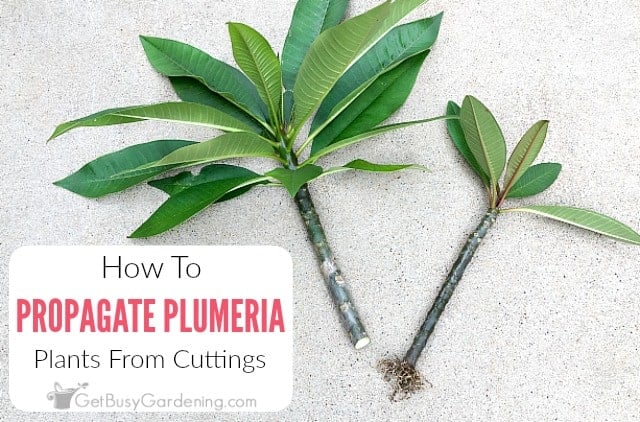
Though it sounds like it would be difficult, plumerias (aka: frangipanim, kalachuchi, or Hawaiian lei tree) are surprisingly quick and easy to propagate.
Below I’ll talk about the different methods you can try, and then dive into all of the information you need to know, including my best tips for success.
It’s fun and addicting once you learn how, and I’ll walk you through the exact steps in this detailed guide for propagating plumerias.
Can You Propagate Plumeria?
Over the years a lot of people have asked me “can I grow plumeria from a cutting?“. Well, I’m sure you know by now that the answer to that question is YES!
Since I’ve been asked that so many times, and I have several years of experience doing it myself, I finally decided to write a step by step tutorial on how you can do it too.
Plumeria Propagation Methods
There are two main ways to propagate plumerias: from seed or by rooting the cuttings.
In this article, I will show you how to grow plumeria from cuttings. I’ll save the seed starting for a future post.
I know it sounds scary, but it is actually pretty easy. First, let’s talk about when is the best time to try it.
When To Take Plumeria Cuttings To Propagate
The best time of the year to take plumeria cuttings for propagation is in the warm spring and summer months, especially when it’s humid outside.
If you take them too late in the summer, or in the fall as the mother plant is starting to go dormant for the winter, then they probably won’t root, or it will be much slower.
Rooting Plumeria Cuttings In Winter
Plumerias go dormant during the winter, so if you take the cuttings too late, they will likely won’t root. However, if you store them correctly, you can overwinter them until spring.
Just wrap the cutting with paper, or leave it in the pot and keep the soil completely dry. You can mist it every once in a while if you want, but don’t overdo it or it could end up rotting.
Then in early spring, give it a good, deep drink, and follow the step by step instructions below for rooting it.
How To Cut Plumeria For Rooting
There are a few things you’ll want to keep in mind when cutting plumeria stems and branches for rooting.
It doesn’t make a difference where you cut it, so it’s just a matter of how big or small you want it to be. You can root any size cutting, but you’ll have the best chance if it’s at least 3-4″ long.
But you do want to be sure to use a sharp pair of pruners, and always sterilize them so you get a nice clean cut.
Also, plumerias are very prone to tip rot, so it’s extremely important to always make your cuts at a downward angle so that water can’t settle into the wound.
How To Grow Plumeria From Cuttings
Before you get too excited and stick your plumeria cutting directly into the dirt, there are a few steps you’ll need to take to prepare it for the best chance of success.
First, remove the leaves from the cutting. This will allow it to put all of its energy into producing new roots, rather than maintaining the foliage.
Second, be sure to allow the wound to cure (dry out) before you attempt to root it. This step is super important, so don’t skip it, otherwise your plumeria cutting will likely rot instead of forming roots.
To do that, simply let it sit in a dry place until the wound is completely callused over. This can take several days to over a week, so be patient, and don’t rush it.
Related Post: How To Grow Plumeria In A Pot
Rooting Plumeria Cuttings In Water
Another common question I get asked is “can I root my plumeria in water?“. The short answer is yes, technically it is possible.
However, rooting frangipani cuttings in water isn’t always a huge success. Many times, the stems will only rot.
If you have plenty of extras to work with, then by all means experiment with this method. It’s always fun to try something new.
My preferred plumeria propagation method however is rooting them in soil. So, I’ll stick to that for now.
Planting Plumeria Cuttings In Soil
The best soil for rooting plumeria cuttings (also called “medium”) is one that is very quick-draining and doesn’t hold much moisture.
I make my own by combining equal parts of perlite, potting soil, and coarse sand, but you can use a commercial mix instead.
When planting a plumeria cutting in soil, it’s very important that you always use a clean pot to avoid any type of contamination.
Also, make sure you don’t use a huge container for rooting each cutting, otherwise you risk overwatering, which will only cause it to rot.
I use 4″ pots for rooting most of mine, and once in a while I might go up to a 6″ one for larger stems or branches.
Related Post: How To Choose The Best Plumeria Soil
Plumeria Cutting Care While Propagating
For the best chance of rooting, keep the air around your plumeria cutting humid, but the soil on the dry side.
If you live in a humid climate like I do, you don’t need to do anything special. Simply leave it outside, and soon it will root. Just be sure to keep it out of the full sun until then.
But, if you live somewhere dry, or you’re trying to root one indoors, then it’s a good idea to mist it every couple of days with a plant sprayer.
Just don’t water the soil, you want that to stay on the dry side. If it’s too damp, it will only cause your plumeria cutting to rot, and you don’t want that.
You’ll know your cutting has successfully rooted once you see new leaves forming the top.
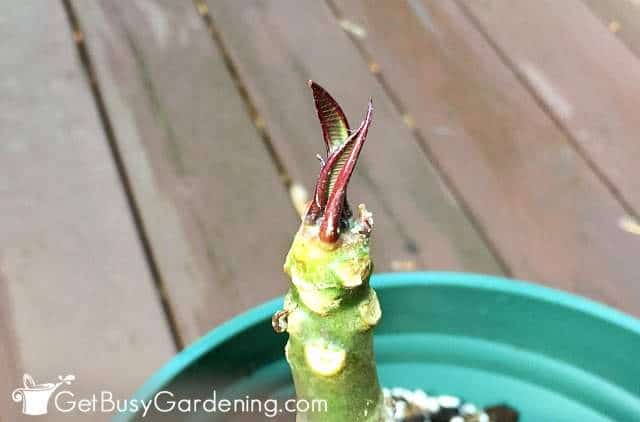
How Long Does It Take Plumeria Cuttings To Root?
How long it takes for plumeria cuttings to root depends on the environment. But in the right conditions, the roots will start forming in as little as 2-3 weeks.
However, if it’s really dry, wet, or too cold, then it will take much longer. For the fastest results, keep them in a bright, warm, and humid location out of the direct sun.
Why Is My Plumeria Not Rooting?
Your plumeria may not be rooting due to over or under watering, lack of light, or the temperature is too cool.
The soil needs to be kept on the dry side at all times, and it should never be wet. A moisture meter can help you maintain the perfect balance
Also, the roots will form best when it’s between 75-85°F. You can use a heat mat placed under the pots to speed things up.

Transplanting Plumeria Cuttings After Propagation
Once your plumeria cutting has several mature leaves, then you know it’s propagated and ready to move into a new pot or the ground.
You certainly don’t need to worry about transplanting your kalachuchi cutting right away, you can leave it in the small container until it becomes pot-bound if you’d rather.
The best potting soil to use is a porous fast-draining mix, and you should always plant them a container that has drainage holes.
Or you can try to make your own by mixing coarse sand and perlite or pumice with general potting soil.
Once your new baby has become established, you can start fertilizing it to encourage flowers, the cuttings can bloom their first year.
Related Post: How To Care For Plumeria Plants (Hawaiian Frangipani)
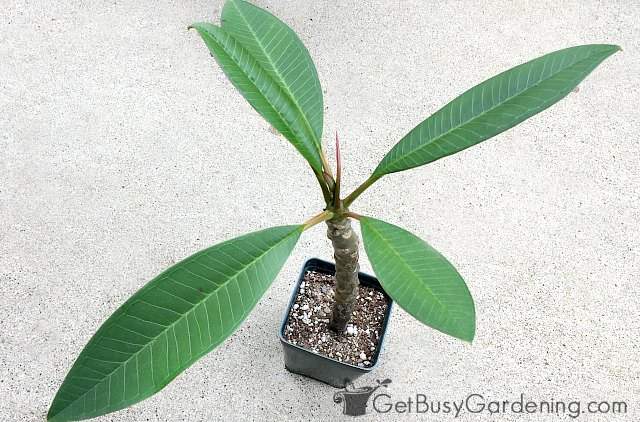
Plumeria Propagation FAQs
Below I’ll give you answers to the most frequently asked questions about rooting plumerias. If you can’t find what you’re looking for here, add a comment below.
Can You Replant A Broken Plumeria Branch?
Yes, with some care, you can replant a broken plumeria branch. Make sure the branch is dry and not rotten. If the broken end is mangled or crushed, then cut off the damaged parts so you have a clean edge. Clip off the leaves, and leave it to dry in a shady place for a few days. Then follow the steps below to root it.
How fast do plumeria cuttings grow?
Plumeria cuttings can grow very fast in the right conditions. It can take as little as 2-3 weeks for the roots to start forming.
How long do plumeria cuttings last?
Plumeria cuttings can last several months without being planting. However, they will slowly start to shrivel over time, so the sooner you root them after they’re properly callused, the better your success rate will be.
Can frangipani be propagated in water?
Yes, frangipani can be propagated in water. However, it’s not the best method to use, as the cuttings can easily rot. It’s a fun experiment to try if you have extras, but for the greatest chance of success, I recommend rooting them in soil.
Can you plant a fresh plumeria cutting?
While you can plant a fresh plumeria cutting, I highly recommend you let dry and fully callus over first. If you try planting it with a fresh cut, it has a much higher chance of rotting rather than rooting.
Plumeria propagation by cuttings sounds like it would be really hard, but it’s actually pretty easy when you follow these steps. It’s really fast too, so once you get the hang of it, you’ll have plenty of new starts to share with friends!
If you want to learn how to multiply any type of plant you can get your hands on, then my Propagation Made Easy eBook is for you! It has everything you need to know in order to start propagating your favorites right away. Download your copy today!
More Plant Propagation Posts
- The Best Plant Propagation Tools, Equipment & Supplies
- Plant Propagation: A Detailed Guide For Beginners
- How To Propagate Aloe Vera By Division
- Propagating Christmas Cactus From Cuttings Or By Division
- How To Propagate Banana Plants
- How To Propagate Snake Plant (Sansevieria) In Water Or Soil
Share your plumeria propagation tips in the comments section below.
Step By Step Instructions
How To Propagate Plumeria Cuttings

Rooting plumeria cuttings is easy once you know the right way to do it. Follow these detailed step by step instructions for the best results.
Instructions
- Take and cure the cutting - Use a clean pair of sharp pruners to take 3" or longer plumeria stem or branch cuttings. Then place them in a dry location out of direct sunlight for at least a week, or until the wound has callused over.
- Prepare the rooting medium - Use a commercial fast-draining medium, or try mixing equal parts of regular potting soil with perlite and coarse sand. If it's bone dry, dampen it slightly. Then use your trowel to fill the pot.
- Apply rooting hormone - Dust the callused end of your plumeria cutting with rooting hormone. This will help it produce strong, healthy roots, and also make the process faster.

- Plant the cutting - Make a hole in the medium that’s deep enough so the cutting will stand up on its own. Put the cut end into the hole, and gently pack the soil down around the base. The roots will sprout out of the bottom of the stem, so you don't have to plant it very deep.

- Place somewhere warm and bright - Put your cutting in a humid location with bright light. Placing it on top of a heat mat can speed things up, but it’s optional. Once you see new leaves on top, that means your frangipani cutting has rooted. You can pot it up into fresh soil if you want, but only go one size larger than the current container.
Notes
- The larger your cutting is, the longer it should cure. You'll know it's ready when the cut feels dry and hard. Do not skip this step or it may end up rotting.
- While your plumeria cutting is rooting, keep the medium on the dry side. If it’s too wet, the cutting will likely rot. You can use a moisture gauge to monitor it.
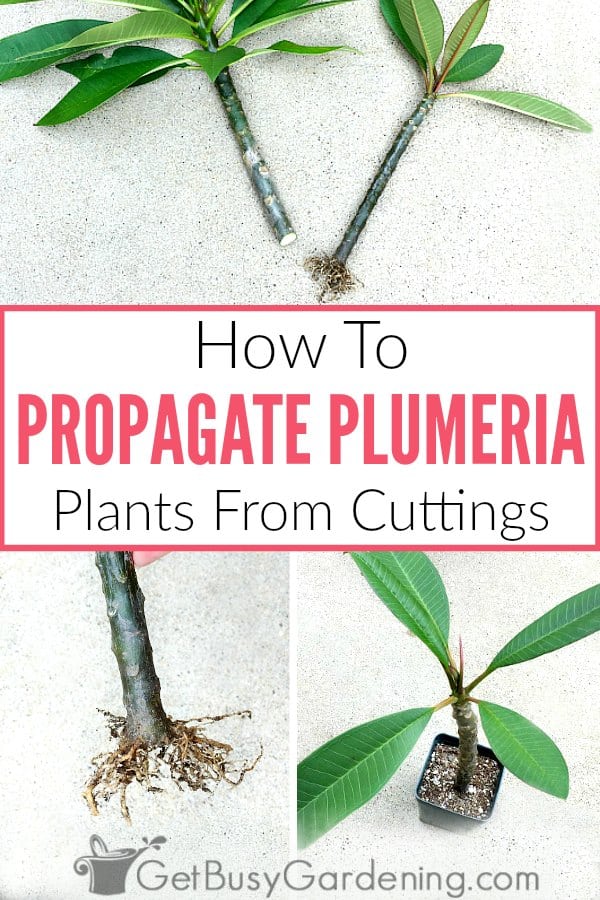
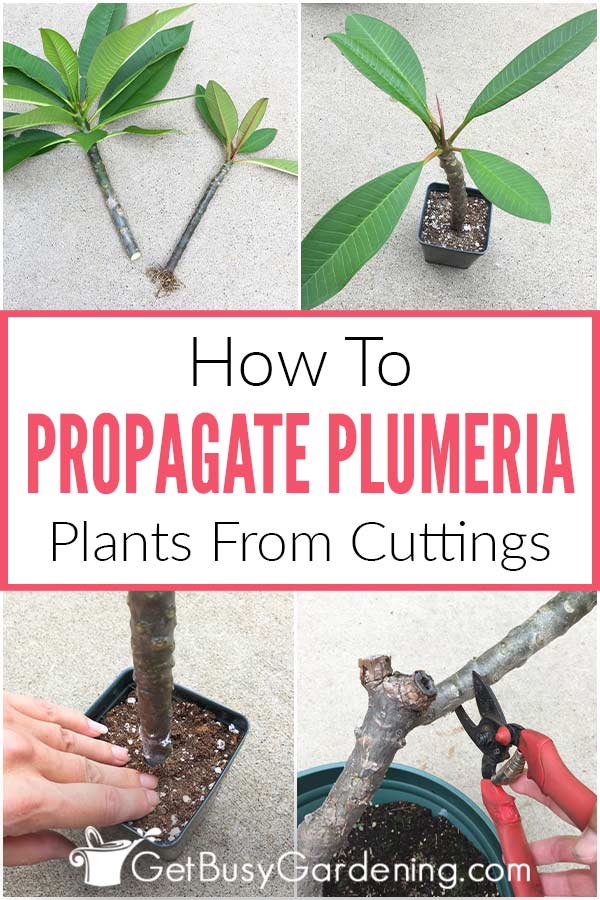
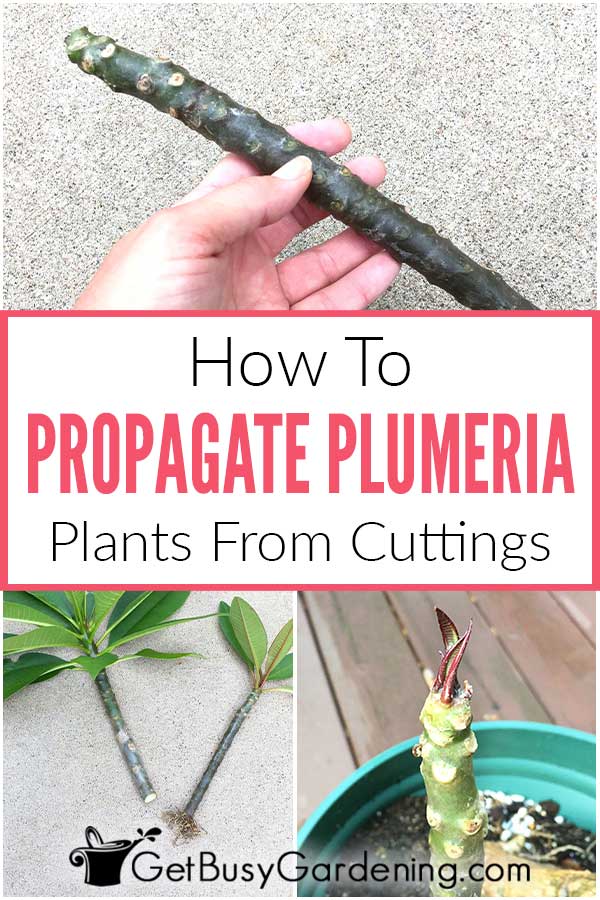

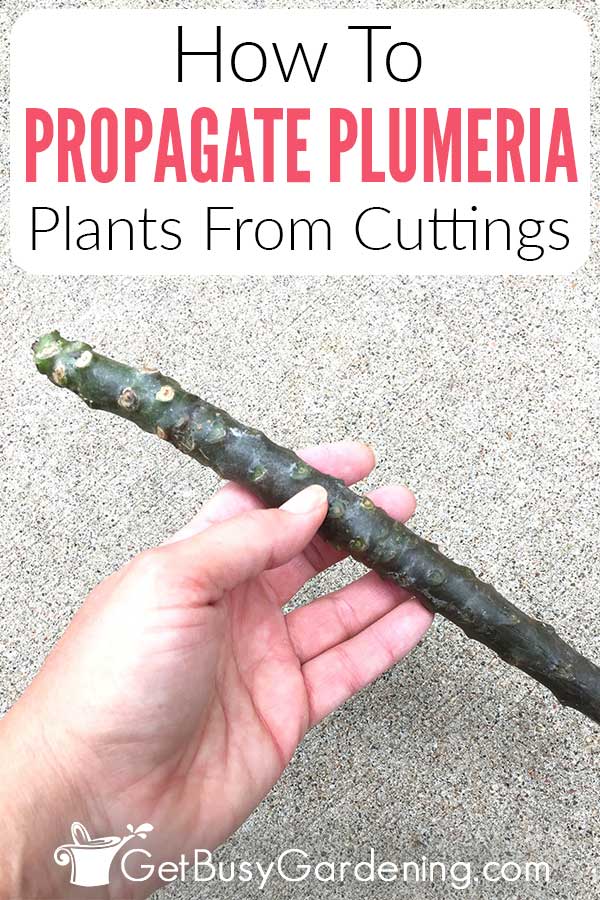

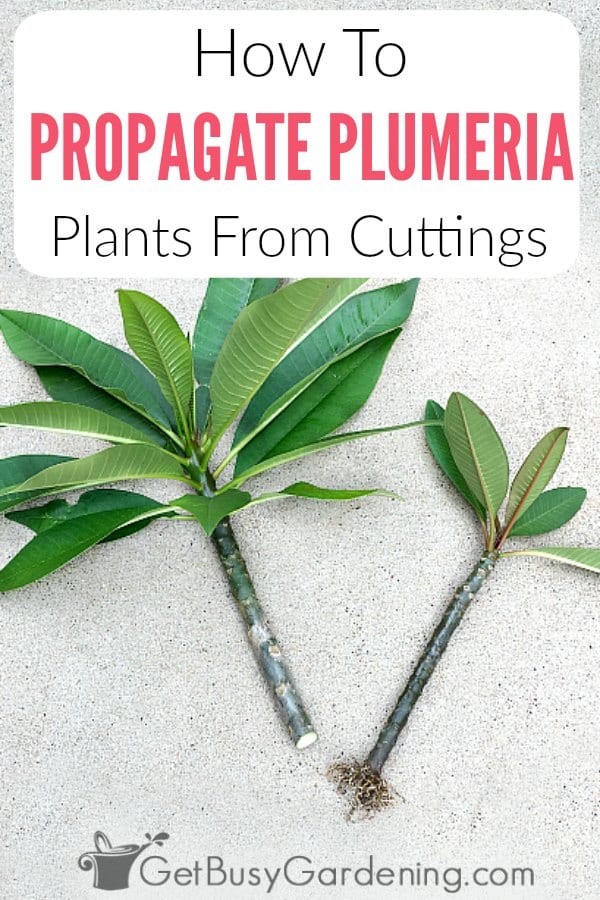

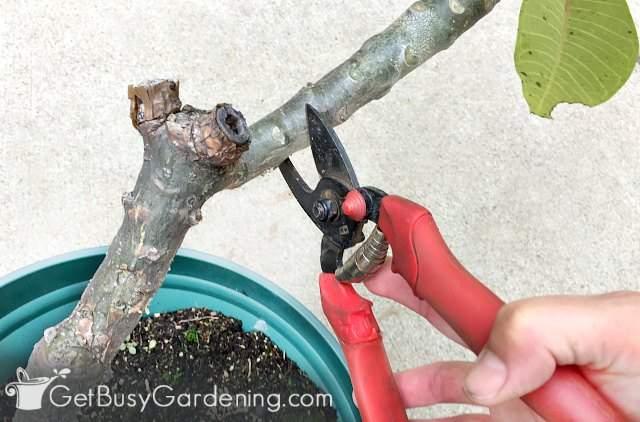
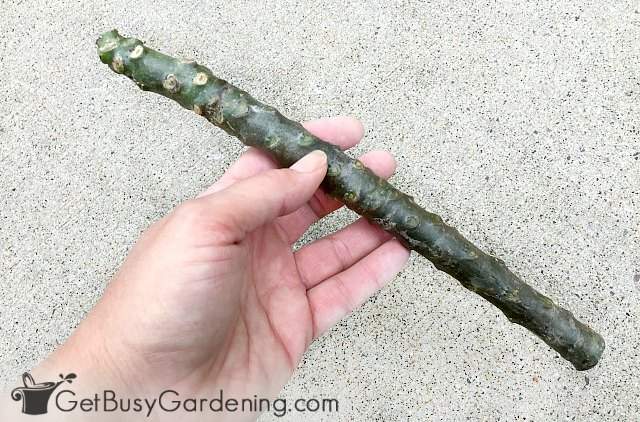


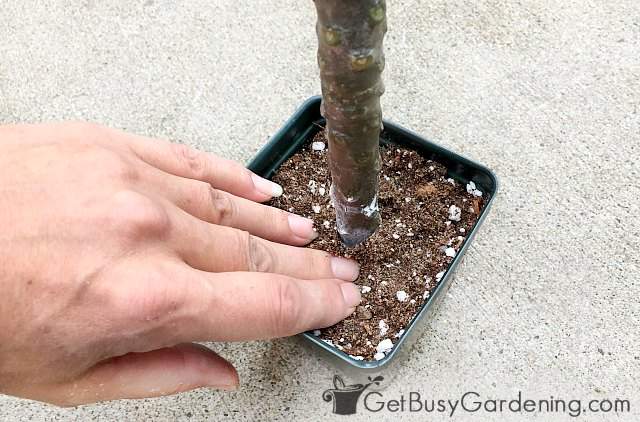

Deede says
I live in a dry climate in AZ. My plumeria looked like it was going to get leaves, but then they never grew. The bottom stem looks brown at the bottom. I pruned off the top and then made several clippings from the tall stem. They look pretty dry and their stems are brown. Will they still grow?
Amy Andrychowicz says
Check to see if the brown stems are firm or if they are mushy. If they feel soft, it could either mean that the plant hasn’t been getting enough water, or that the stem is rotting. If the soil is completely dry, I would water it and wait a few days to check to see if the stem feels firmer. If it doesn’t firm up after watering or two, that’s a good indication that it is rotting from the bottom up. In that case, the only way to save it is to take cuttings and root them. I would definitely propagate the cuttings you took from your plumeria, just in case. Here’s my guide that will give you more care details… How To Grow Plumeria Plants. Good luck!
Joan says
We had 2 plumeria plants, they was doing good had a lot good leaves on them & was hoping for a flower soon! That night someone cut both our plants off. My grandsons was ver upset along with my daughter! Can we regrow the ones that was cut? All is left is the sticks part, they cut all the leaves also, the bottoms are dried out , the other part is still in the pot, or should we get new ones?
Amy Andrychowicz says
Wow, what a terrible thing to have happen!! I can’t believe someone would do that, I’m so sad for you. The good news is that plumeria plants can take a hard pruning, and still grow back. Just keep caring for the remaining trunk as you would if it was still the whole plant, and soon you should start to see new growth coming out just below the cuts. It may take several weeks, but don’t give up. I have my fingers crossed for you (and for karma to get back at that mean person who butchered your baby!!). On a side note: if it does recover, and once it starts getting bushy again, I would move it somewhere out of public reach.
Joan says
My daughter & grandsons r once again happy 😃 I did wat u said ( my daughter was doubtful ) & the ones that was brutally cut off r now got little leaves & the 2 other one have gotten little knobs around the cut off area with leaves growing off them like crazy!! Thank u so much for ur help! The mean person gave us 4 plants instead of 2!😎
Amy Andrychowicz says
Woohoo! I’m so happy to hear that your plumeria is growing back now. That is wonderful news!
Sarah says
Did you get around to making the plumeria seeds article? I would love to read that one as well.
Amy Andrychowicz says
No, not yet. 🙁 Hopefully some day I’ll be able to get some seeds from my plumeria so I can try it out.
Linda R Wilming says
How big of diameter can you cut?
Amy Andrychowicz says
It doesn’t matter, you can root a plumeria cutting at any diameter. Just make sure you take the cutting from a mature plant, and that it’s several inches long.
Michelle Whitaker says
Can I cut a long piece into multiple pieces for rooting?
Amy Andrychowicz says
Yes, you can root any part of a plumeria stem.
Consuela says
Hi I put 4 in a 5 gallon pot. They are doing well. They have started to produce leaves. I’m in Florida. When is a good time to put them in the ground?
Amy Andrychowicz says
Awesome, glad to hear your plumeria cuttings are doing well! Spring is the best time to plant them into the ground. Where you live, make sure to plant them while it’s still cool, and definitely before the weather gets too hot.
Andy Geib says
I just got some plumeria clippings and put them right in the ground. I realize now that was a mistake. The leaves are all drooping badly. Is there any way to save it?
Amy Andrychowicz says
I would pull your plumeria cuttings out of the ground, and check to make sure they aren’t rotting. Also, it’s best to remove the leaves from the cuttings before you try rooting them. Otherwise, the cuttings will use up all of their energy trying to keep the leaves alive, rather than focusing on growing roots. If your cuttings are still firm and healthy, then follow the instructions above for rooting them. Good luck!
Alicia clutts says
I just received a plumeria cutting. I’m in Southern California and it’s pretty warm right now. Mid 80’s. The clipping I received is very large. What size pot should I use?
Amy Andrychowicz says
You don’t need to use a very large pot for rooting your plumeria cutting, it doesn’t need much space for that. I usually use a 4″ or 6″ sized pot for mine. Don’t go too big on the pot size, or you can risk overwatering because a large amount soil will hold water longer. Once the cutting starts growing new leaves, and the roots are established, you can pot it up into a larger container.
Sherry Kizer says
Hi Amy, Your articles are great! My neighbor just pruned her Plumeria trees today. She gave me 5 cuttings! I have been reading a lot today. Her trees are outside in the ground in central FL & about 4 ft tall. The cuttings are aprox 2-3 ” in diam. 2 are 14 ” long, .One is 13″ long with 3 offshoots at the top 8, 9,.& 10 ” , one is 24″ long with 3 offshoots 4, 5 & 8″, and finally, one 20″ with an 18″ coming off that which has 2 offshoots 3″ long. All are full of leaves and buds. I want to propagate all that I can and I don’t know where to begin separating, and how much I can actually use. I rent so I want to put them in pots so I can take them with me when I move again. I want to keep them outside. I have a NW side screened porch that does not have great air movement and is my high humidity spot, lots of light but not much direct sun except on the west side in late afternoon, early evening, a SW side patio with an awning on 1/2 which gets sun & shade, & a SE side covered patio which gets sun & shade. This is where I keep the succulents. Both have a nice breeze, when there is a breeze. I also have plenty of yard all the way around with some trees. I have never had this plant before and I have never propagated in soil before. I am a bit overwhelmed. I have them in the shade drying the ends but it’s FL and our afternoon rain is moving in. Thinking I can move them to the screen room but not sure if that will be too humid to properly dry the exposed ends. Everything I have read says to remove all of the leaves. I’m thinking the buds won’t bloom now anyway but there are some really new baby leaves on the tops too. I saw pix of cuttings with some new baby leaves on the top being readied for rooting. I know the cuttings need lots of energy to root but I so hate the thought of cutting everything off. Also, given the length and diameter, what size pots to start them in, width and depth? I have a bunch of potted succulents so I will be using the cactus soil. Also some of the leaves have rust fungus so I know I need to get rid of those for sure and possibly treat whatever is left (?) How do I remove the leaves, cut them or pop/pull them? Wow, so much for a beginner to think about. LOL Would really appreciate a little help. Thank you.
Amy Andrychowicz says
Congrats on scoring some plumeria cuttings. The good news is that it sounds like you have plenty to experiment with. Yes, put your cuttings into your porch or another protected area to dry so they don’t get wet when it rains. You can remove all of the largest leaves, but keep the baby ones on top, and also cut off any flower buds. The reason for that is you want the cutting to put all of its energy into developing new roots, rather than wasting it on keeping the leaves and flower buds alive. It’s best to cut the leaves off, rather than trying to pull or break them. Cut them as close to the stem as you can, any tiny nub that’s left will eventually turn brown and drop off. You can root any size cutting, so just make them a manageable size for your space. Though you don’t need a very large pot, use one that is proportionate to the height of the cutting so it will stay upright. If they’re in a large post, just be extra careful not to overwater them. In fact, in a humid climate like FL, it’s probably going to work better if you don’t water the soil at all. Good luck and have fun!
Mary Fuller says
One limb was damaged to the point of no return. I cut it off and have placed it in water but will put it in soil today. Problem is it has 2 seed pods I don’t want to lose. Help.
Amy Andrychowicz says
Yes, definitely take your plumeria cutting out of water, as it will likely just rot in there. Unfortunately, since it has seed pods, it may not end up rooting. Producing seeds takes a lot of energy from a plant. So, if you leave the seed pods on there to mature, then the cutting probably won’t have enough energy to grow roots. It certainly won’t hurt to try though, so don’t give up. Think of it as an experiment. 🙂
Mary says
Thank you so much for the information. I’m going to try and save the pods. I think because it’s so dry here that the deer got to them. I know something was eating on them.
Stefany says
Hi! I just received a plumeria cutting and it’s still warm in zone 8b (Mid-September). Should I try potting it and leave it outside for a while until it gets cooler? Would it be better to try and store it over the winter? If so, what’s the best way to store it? Thank you!
Amy Andrychowicz says
I would try rooting your plumeria cutting now, rather than storing it until spring. They tend to root pretty quickly when it’s warm and humid. If might not grow any leaves this late, but if it has roots before you have to bring it inside, then it’ll have a better chance of surviving until spring. Here’s a post about how to care for plumerias that will help you keep it alive until spring.
Daniel dunderman says
I have been somewhat of a Mr green-jeans and can grow anything from grass from seed, to to roses, vegetables, to trees, palms and beyond. my favorite are plumeria. i have over the years asked for cuttings from numerous customers, nurturing them to beautiful plants that produce beautiful flowers and are extremely healthy flourishing plants. now my problem is they are way to large in all 4 areas and are beauties, but i absolutely must move them from where they are. how can I. or can I take these huge beautiful mature plants and move them to several locations that have available without killing them or harming them?
Amy Andrychowicz says
If your large plumerias are in the ground, then it would be very difficult to transplant them. They are trees and, like any other tree, the larger they get, the harder it will be to move them. I would manage their size by pruning instead of trying to relocate them. If you mean that you want to relocate them because you are moving, then I would just take a bunch of cuttings and root them, then move those with me.
Lety says
I just bought 2. Cutting
S in Florida and brought them back to California , the placed them in plastic bags with rooting powder. I had them indoors for 6 days then in shipping tube for 1 or 2 days . By the 7 day they started to callous but the inside was concaved. Anything thing is that the were already starting to feel soft. Afraid they would rot I plated them. I think one had already rotted since it’s very soft, the other seems to be progressing it has not softened more but but the stem is looking old. Do you think it will still grow? And did I do something that made them go soft ?
Amy Andrychowicz says
Keeping your plumeria cuttings in a plastic bag is probably what caused them to rot. They need to dry out before planting them, and a plastic bag would hold way too much moisture for them. As for whether or not they will grow… it’s hard to know for sure. Time will tell. Good luck!
NIcole Abboud says
I left the plumeria cuttings for about 5 days as recommended prior to planting in soil and both are soft in the middle and the outside has turned a powdery shade of white. How can that be prevented next time?
Amy Andrychowicz says
It sounds like your plumeria cutting may have been exposed to too much moisture/humidity while it was curing. Next time, try putting it in a dry location, perhaps inside a climate controlled home or garage.
Robin Gower says
I propogated a Plumeria and gave to my friends, about 2 months ago. The tips are pretty soft and I am concerned about tip rot. Also, how long before they will start growing leaves? I have never done this before, so I am afraid I messed something up in the process. The plants are outside – we live in Missouri and it gets pretty hot. Just wondering if there are some tips I can give them so they are able to enjoy their plants at some point… Right now I think they think I am nuts! They look like bare, naked stems. 🙂
Amy Andrychowicz says
In the right environment, it only takes a week or two for plumeria cuttings to grow roots. Keep them out of the direct sunlight, make sure the soil stays on the dry side, but the air is humid. If the soil is too wet, then the cuttings will only rot. If the tips are mushy, then it may be a lost cause. But if they are only a little soft, then they might still have a chance. If the soil has been completely dry this whole time, then I could give it a little water. Allow the soil to dry out completely, and then give it a deep drink (until water comes out of the drainage holes), then let it dry out again and repeat. Hope this helps.
Robin Gower says
Thank you for the info. Should we try to cut off the soft parts of the cutting? Would that possibly help at all?
Amy Andrychowicz says
If the tips of your plumeria cuttings have rotted, then yes, you should cut the off and remove all of the rot. Otherwise it will just keep spreading, and eventually kill the cutting. Otherwise, if it’s just soft from dehydration, then no, there’s no need to cut the tips off.
Sandy Torrens says
I am outside Atlanta, Ga. and we had a storm last night that broke off two of my only limbs of my yellow Plumeria that just bloomed yesterday. So your propagation information is very helpful, thank you. My only question is that when the limbs broke, one split down one side. Will that hurt the plant any? As far as getting any type of disease? Or will it just grow over and more leaves come in?
Amy Andrychowicz says
Awe, what a bummer! But I’m so glad to hear that you’ll be able to propagate the plumeria branches that broke off! You’re welcome. 🙂 If you can, I would prune the split branch back so it has a cleaner wound (be sure to make the cuts at a downward angle). If it’s not possible, then just keep an eye on it. It should heal over just fine, but plumerias have a tendency to get stem rot if water gets into the would and settles there. Hope yours will recover just fine!
Vangie says
I planted my cuttings about two weeks ago and haven’t watered it since, am I supposed to and if so how often should i watter them?
Amy Andrychowicz says
They key it to keep the soil on the dry side, and the air around your plumeria cutting humid. So, you usually won’t need water it at all until the cutting has roots. You’ll know it has roots once new leaves start growing on it. If the cutting starts to shrivel, then you can either mist it or give it a bit of water, but not a lot. The soil should never be soggy.
Vangie says
I just planted my plumleria cutting and left them outside, do I need to take them inside the house when it rains?
Amy Andrychowicz says
The soil your plumeria cutting is in should dry out between waterings. So, if it’s going to rain a lot, and the soil can’t dry in between, then I would move it to a protected area or indoors to allow it to dry out. If the soil stays too wet, the cutting will rot.
Vangie says
Thank you so much for your information. Stay safe and God bless!
Amy Andrychowicz says
You’re welcome, you too. 🙂